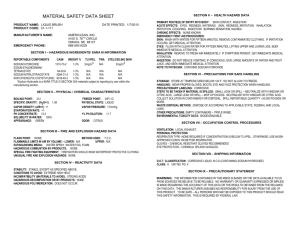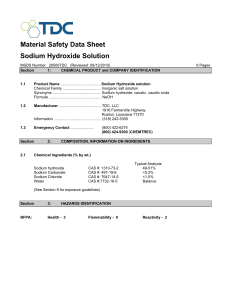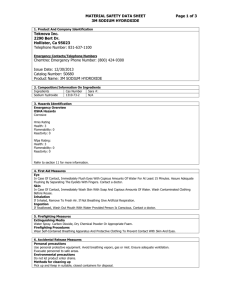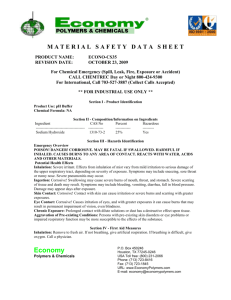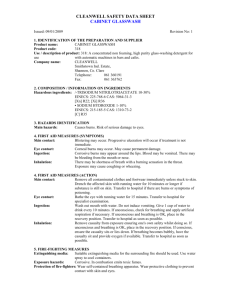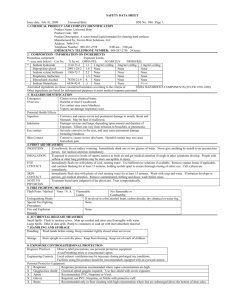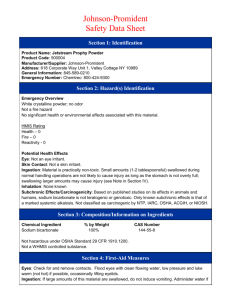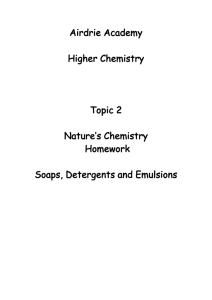MATERIAL SAFETY DATA SHEET DECK STRIPPER ALPR
advertisement
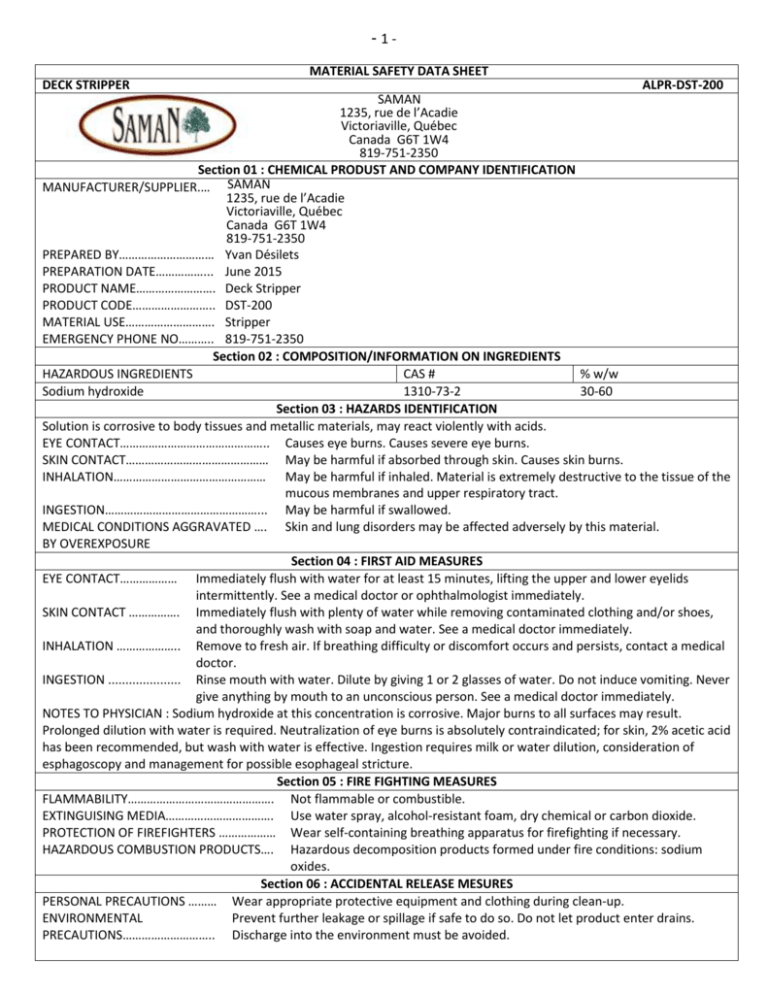
-1MATERIAL SAFETY DATA SHEET DECK STRIPPER ALPR-DST-200 SAMAN 1235, rue de l’Acadie Victoriaville, Québec Canada G6T 1W4 819-751-2350 Section 01 : CHEMICAL PRODUST AND COMPANY IDENTIFICATION MANUFACTURER/SUPPLIER.… SAMAN 1235, rue de l’Acadie Victoriaville, Québec Canada G6T 1W4 819-751-2350 PREPARED BY………………………… Yvan Désilets PREPARATION DATE……………... June 2015 PRODUCT NAME……………………. Deck Stripper PRODUCT CODE…………………….. DST-200 MATERIAL USE………………………. Stripper EMERGENCY PHONE NO……….. 819-751-2350 Section 02 : COMPOSITION/INFORMATION ON INGREDIENTS HAZARDOUS INGREDIENTS CAS # % w/w Sodium hydroxide 1310-73-2 30-60 Section 03 : HAZARDS IDENTIFICATION Solution is corrosive to body tissues and metallic materials, may react violently with acids. EYE CONTACT……………………………………….. Causes eye burns. Causes severe eye burns. SKIN CONTACT……………………………………… May be harmful if absorbed through skin. Causes skin burns. INHALATION………………………………………… May be harmful if inhaled. Material is extremely destructive to the tissue of the mucous membranes and upper respiratory tract. INGESTION…………………………………………... May be harmful if swallowed. MEDICAL CONDITIONS AGGRAVATED …. Skin and lung disorders may be affected adversely by this material. BY OVEREXPOSURE Section 04 : FIRST AID MEASURES EYE CONTACT……………… Immediately flush with water for at least 15 minutes, lifting the upper and lower eyelids intermittently. See a medical doctor or ophthalmologist immediately. SKIN CONTACT ……………. Immediately flush with plenty of water while removing contaminated clothing and/or shoes, and thoroughly wash with soap and water. See a medical doctor immediately. INHALATION ……………….. Remove to fresh air. If breathing difficulty or discomfort occurs and persists, contact a medical doctor. INGESTION ..................... Rinse mouth with water. Dilute by giving 1 or 2 glasses of water. Do not induce vomiting. Never give anything by mouth to an unconscious person. See a medical doctor immediately. NOTES TO PHYSICIAN : Sodium hydroxide at this concentration is corrosive. Major burns to all surfaces may result. Prolonged dilution with water is required. Neutralization of eye burns is absolutely contraindicated; for skin, 2% acetic acid has been recommended, but wash with water is effective. Ingestion requires milk or water dilution, consideration of esphagoscopy and management for possible esophageal stricture. Section 05 : FIRE FIGHTING MEASURES FLAMMABILITY………………………………………. Not flammable or combustible. EXTINGUISING MEDIA……………………………. Use water spray, alcohol-resistant foam, dry chemical or carbon dioxide. PROTECTION OF FIREFIGHTERS ……………… Wear self-containing breathing apparatus for firefighting if necessary. HAZARDOUS COMBUSTION PRODUCTS…. Hazardous decomposition products formed under fire conditions: sodium oxides. Section 06 : ACCIDENTAL RELEASE MESURES PERSONAL PRECAUTIONS ……… Wear appropriate protective equipment and clothing during clean-up. ENVIRONMENTAL Prevent further leakage or spillage if safe to do so. Do not let product enter drains. PRECAUTIONS……………………….. Discharge into the environment must be avoided. -2METHODS FOR CLEAN UP ……… Soak up with an inert absorbent material and dispose of as hazardous waste. Keep in suitable, closed containers for disposal. Section 07 : HANDLING AND STORAGE HANDLING PROCEDURES …………... During handling of liquid, prevent contact with skin and eyes by using adequate personal protective equipment. Avoid inhalation of vapor or mist. STORAGE NEEDS…………………………. Keep container tightly closed in a dry and well-ventilated place. Containers which are opened must be carefully resealed and kept upright to prevent leakage. Section 08 : EXPOSURE CONTROL/PERSONAL PROTECTION EXPOSURE LIMITS………………. Sodium Hydroxide: ACGIH 2 mg/m3 (ceiling); OSHA 2 mg/m3 (PEL) ENGINEERING CONTROLS…… Adequate engineering controls and/or personal protective equipment must be used to prevent contact with skin and eyes. Engineering controls and/or respirators may be necessary when the generation of airborne mists or fogs are possible. EYES AND FACE ………………….. Chemical goggles (and face shield if necessary) should be worn to prevent contact. RESPIRATORY……………………… Wear full face-piece respirators approved by MSHA / NIOSH if mists are expected. PROTECTIVE CLOTHING ……… Rubber or vinyl apron. Rubber boots or rubber overshoes. GLOVES ……………………………… Impervious rubber or vinyl gloves with gauntlets. Thoroughly wash the outside of gloves with soap and water prior to removal. Inspect regularly for leaks. HYGIENE MEASURES ………… Handle in accordance with good industrial hygiene and safety practice. Wash hands before breaks and at the end of workday. Section 09 : PHYSICAL AND CHEMICAL PROPERTIES PHYSICAL STATE………………………………… water white liquide ODOUR……………………………………………… no appreciable odor SPECIFIC GRAVITY (WATER=1)…………… 1.53 PH…………………………………………………...... 14 BOILING POINT (°C)……………………………. 140 °C (284 °F) FREEZING POINT (°C)………..……………….. - 12 °C (10 °F) VAPOR PRESSURE (mm Hg)……………….. < 18 at 20 °C (68 °F) VAPOR DENSITY (AIR=1)…………………….. 1.38 EVAPORATION RATE………………………….. not available VOC ………………………………………………… 0 SOLUBILITY IN WATER……………………….. complete Section 10 : STABILITY AND REACTIVITY CHEMICAL STABILITY…………………………………………. Stable under recommended storage conditions. CONDITIONS TO AVOID …………………………………….. Contact with acids, organic materials, chlorinated solvents, aluminium, phosphorus, tin/tin oxides, zinc. HAZARDOUS PRODUCTS OF DECOMPOSITION…… Sodium oxides are formed under fire conditions. HAZARDOUS POLYMERIZATION…………………………. Will not occur. Section 11 : TOXICOLOGICAL INFORMATION SODIUM HYDROXIDE LD 50………………………………………………………………. Rabbit (oral) : 500 mg/kg Rabbit (dermal) : 1350 mg/kg Section 12 : ECOLOGICAL INFORMATION SODSIUM HYDROXIDE Ecotoxicity : The damaging effects are mostly a consequence of the increase in pH. LC 50………………………………………………………………. Bluegill sunfish : 99 mg/l (48 h) Mosquito fish: 125 mg/l (96 h) Brown shrimp (Crangon crangon): 30-100 mg/l (48 h) Persistence and degradability: No data available. Section 13 : DISPOSAL CONSIDERATIONS WASTE DISPOSAL…. Disposal in accordance with applicable regional, national and local laws and regulations. Section 14 : TRANSPORT INFORMATION TRANSPORT OF DANGEROUS GOODS REGULATIONS PROPER SHIPPING NAME …. Sodium hydroxide solution -3UN NUMBER…………….. TRANSPORT CLASS……. PACKING GROUP………. REPORTABLE QUANTITY …….. MARINE POLLUTANT …………. POISON INHALATION HAZARD ….. UN1824 8 II 2000 lbs No No Section 15 : REGULATORY INFORMATION WHMIS CLASSIFICATION…….. E, corrosive material HMIS CODES ………………………. Health 3 Flammability 0 Physical Hazard 1 Personal Protection (PPE) J Protection J = splash goggles, gloves, apron and a dust/vapor respirator Section 16 : OTHER INFORMATION To the best of our knowledge, the information contained herein is accurate. However, neither the above named supplier nor any of its subsidiaries assumes any liability for the accuracy or completeness of the information contained herein. Final determination of suitability of any material is the sole responsibility of the user. All materials may present unknown hazards and should be used with caution. Although certain hazards are described herein, we cannot guarantee that these are the only hazards that exist.
